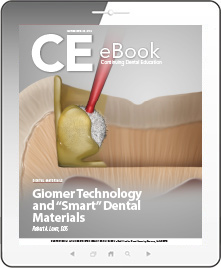Giomer Technology and "Smart" Dental Materials
Released: Tuesday, October 23, 2018
Expires: Friday, April 30, 2021
By Robert A. Lowe, DDS
Commercial Supporter: Shofu
One of the goals in the creation of new composite materials is to simplify the placement of direct composite resins without compromising the quality of the final result. Advancements have been made that allow clinicians to deliver high-quality restorations using direct tooth-colored restorative materials that can give patients a functionally esthetic, long-lasting result. Materials science continues to develop and refine tooth-colored filling materials that are more biologically harmonious with natural teeth and are "smart" because they can help protect teeth and restorations. Giomer technology incorporated into direct restorative materials gives the clinician a material that does more than fill teeth: it can also provide biologic benefits that can potentially extend the life of the restoration and the tooth. The Giomer line of restorative materials includes bulk-fill (flowable and paste) options as well as conventional and low-shrink nanohybrid materials. Other materials options that help not only preserve but rebuild damaged teeth continue to be developed.
LEARNING OBJECTIVES:
-
Describe the basic differences between the direct composite materials currently in the marketplace.
-
Choose the composite technology that best suits the patient's clinical situation.
-
Discuss how to significantly reduce chair time and stress in placement of composite restorations, particularly in Class II interproximal situations.
-
Explain how Giomer technology can help clinical outcomes when placing composite restorations in areas where lack of effective plaque removal can influence clinical longevity.
About the Author
Robert A. Lowe, DDS, Diplomat, American Board of Aesthetic Dentistry, Charlotte, North Carolina
